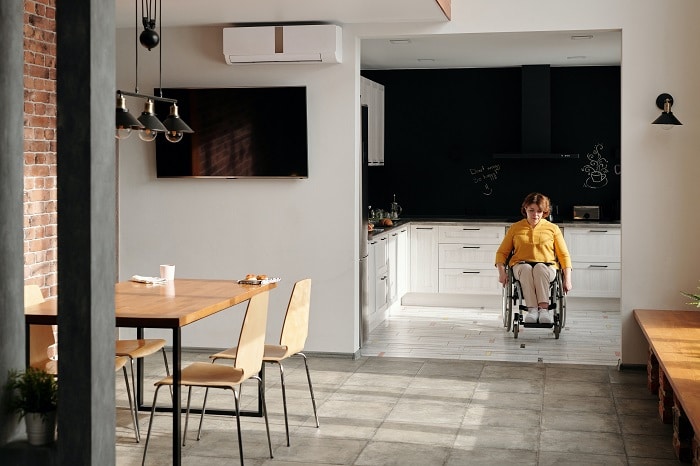
We recently spoke with Samantha Prior from Empowered Liveability – which offers new homes for people with disability to live in – to learn more about what SDA and SIL are, and what to consider if you want to access them.
Samantha: We are an SDA provider. We work with both independent and family investors to build SDA properties, and tenant them to National Disability Insurance Scheme (NDIS) participants. We currently have houses in Victoria, Western Australia and Queensland.
Samantha: SDA refers to houses that are custom-built for disability, and fall into four SDA categories:
Often, two or three people live together as housemates in SDA housing, but those wishing to live alone can be approved for single occupancy.
SIL is when NDIS-funded support workers come into a participant’s home to support them and provide assistance with daily tasks so they can live independently and build their skills. This kind of support can be provided to participants in SDA and other types of accommodation.
Samantha: Participants who are eligible to access SDA and SIL meet certain functional capacity requirements. To access SDA, a participant must show that where they are currently living is not suitable for their abilities, and also demonstrate they require a specific home to accommodate them to live independently.
To live in SDA, a participant must demonstrate they have a functional need for a home that has been modified or built to accommodate their needs.
SIL supports are in-home supports that enable a person to live as independently as possible in their home. To access SIL supports, a participant must demonstrate they need assistance with daily tasks to support them to live independently and build their skills.
Samantha: Currently people cannot access SDA or SIL supports if they are not in the NDIS. Not everyone in SDA has or wants to have SIL – and not everyone with SIL wants or is eligible for SDA.
Samantha: If you are new to the NDIS and don’t yet have a support coordinator, reach out to your Local Area Coordinator (LAC) or NDIS planner to ask about SDA and SIL. By including ‘to live independently’ as a medium or long term goal in your NDIS plan, you can work with your LAC or support coordinator (if you have one) to investigate it further.
If there are changes within your current home with respect to informal supports, you can – with the help of your LAC or support coordinator – put in a ‘Change of Circumstances’ request. Your LAC or support coordinator can assist you with finding an Occupational Therapist (OT) if you don’t already have one to begin a functional capacity assessment for home and living supports.
To undertake the assessment, the OT will come into your home and observe your ability to do things like use the kitchen and bathroom, get in and out of bed, access your dwelling, and more. They will also assess you in the community to determine how much support you’ll need to outside of your home. Combined, the in-home and community assessments will help to determine how much support you require on a day-to-day basis.
Once the functional capacity assessment is completed and a report is sent to the National Disability Insurance Agency (NDIA), it will be considered as part of determining whether or not you need a SIL package, an SDA package, or both.
Samantha: If a participant in SDA doesn’t require – or doesn’t have – SIL funding, they can still use funding from their Core Supports budget to access support workers, in the same way they would if they were living with a family member or carer.
Samantha: Access to SDA is not a quick process – particularly if a participant is going to move into a property with more than one person.
At Empowered Liveability, we take the time to match tenants who are compatible. Because of this, it can take anywhere from three to 12 months to get a property tenanted.
Samantha: We don’t like to put more than three participants into a home with one overnight support. If you have more than three people in a house, realistically you’d need to have anywhere from four to seven support staff in place to make sure everyone gets their morning routines done – that’s a lot of people! Plus, coming home to a house of 10 isn’t very practical, or conducive to a happy home life.
You can have SDA that’s single and double occupancy too – it depends on the size of the dwelling and also what it has been determined that a participant needs to live safely in their own place.
Samantha: SDA isn’t confined to specific locations and can be found in a lot of different neighbourhoods. We build SDA homes to look like every other house in the street. They can be houses, villas, duplexes and also full amenity apartments in the heart of the CBD.
SDA residents pay around 25-30 per cent of their Disability Support Pension (which they receive from Centrelink) towards SDA, plus 100 per cent of their Commonwealth Rent Assistance payment. A participant’s rental contribution for living in SDA equates to approximately $300-$330 per fortnight. The NDIS also pays a contribution to the landlord for the use of their property.
Empowered Liveability works like a real estate company – we manage the property and collect the rent, which is then transferred to the property owner or landlord. We also carry out maintenance checks and are a point of contact point for tenants if there are any issues.
Samantha: It’s always worth considering appealing a decision from the NDIA if you don’t agree with it. If your request to access SDA or SIL supports is unsuccessful, you may not have demonstrated – to the extent the NDIA wants – why you require them. Speak to your LAC or support coordinator about how to get the decision reviewed within 90 days of receiving it, and you may also wish to speak with your OT and your SDA provider (if you are working with one).
Before you even request access to SDA or SIL supports, make sure you are working with an OT who has experience with SDA housing applications, because they’re not easy. The application alone is 25-30 pages of reporting and takes a lot of time and effort.
Samantha: Currently, there is a really low and delayed approval rate for SDA – which means we have a lot of people in their 30s and 40s sitting in aged care facilities who are too young to be there, or in hospitals where they are taking up beds. This comes down to a lot of people not understanding the process for applying for SDA and SIL supports.
To fix this, we need a wider understanding of SDA and the people who need it, and more OTs, LACs and support coordinators who know exactly how to help a participant to get into SDA. I hope to see more people in those roles in the future, and broader education about SDA and SIL supports, so those wishing to live independently are able to do so.
If you have questions about SDA or SIL supports, or other disability discussion points, be sure to log on to Kinora – an online community created by My Plan Manager to help people with disability and their supporters to connect with peers, NDIS experts, disability sector professionals and service providers.


